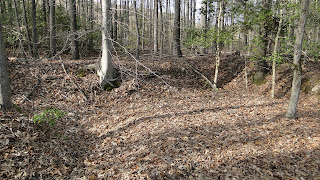Sometimes things don't work out as we plan, and yesterday was a good example. I decided to take a March Madness break for a few hours and go for a hike, my first in boots since the foot surgery 8 weeks ago. I chose the Cumberland Marsh Natural Area, a place that I had never been. It has what sounds like a nice 4.5 mile hike with the possibility of seeing marsh birds and other wildlife. So off I went!
As I reached the tiny, and empty, parking lot 50 minutes later, I pondered why no one else would be here on such a nice spring day. I got out of my car and approached the informational board, on which was posted a large sign saying that the area was closed because of unstable dams. Damn indeed! My car gets about 52 mpg on a trip like this, but even so, I had just wasted nearly a gallon of gasoline! I turned around and headed back, deciding for a shorter hike at the North Anna River Battlefield Park instead. It would be about 15 miles out of the way to the north on the way back.
The North Anna River site marks a vicious battle fought near 150 years ago on May 23-26, 1864 as Grant kept trying to get around Lee's army on the way to Richmond. It happened shortly after the much bloodier battle at
Spottsylvania Courthouse and just before the huge and very bloody battle at Cold Harbor. Because of a strong Confederate defensive position, the river, and Union mistakes - including an ill-advised attack by a stone-cold drunk general - the US Army became divided into three parts. Lee was ill, and his generals could not execute his battle plan without him. Thus, his battered army could not take advantage of a golden opportunity. Otherwise, this could have been a very bloody battle, and a large part of Grant's army might have been destroyed or captured. I would guess that for the 5,000 men who were killed, wounded, or captured, it was plenty bloody and miserable enough.
It never fails to strike me how peaceful these battlefields are today, in sharp contrast to the violence, pain, and misery that once occurred on these bucolic grounds. The photograph of the poem at the end of this post sums up that sentiment very well.
The 2.5 miles of out and back walking are mostly level and easy. What are woods today would have been mostly open country at the time of the Civil War:
The Confederate Army dug extensive defensive trenches here. Nearly 150 years later, many of them are still in evidence. They built a strong defensive position with the North Anna River on one side and a trench line like an inverted "V" - such as the point of a spear.

Even though the trail was flat, the surrounding terrain is often steep. Here, you can get a hint of the North Anna River right at the end of the defensive works and several hundred feet below. It must have been hellish to have to fight a battle on these grounds.
At the entrance to the park is a memorial plaque with a very apt poem of reconcilliation it. We are one country now, not many.




 Even though the trail was flat, the surrounding terrain is often steep. Here, you can get a hint of the North Anna River right at the end of the defensive works and several hundred feet below. It must have been hellish to have to fight a battle on these grounds.
Even though the trail was flat, the surrounding terrain is often steep. Here, you can get a hint of the North Anna River right at the end of the defensive works and several hundred feet below. It must have been hellish to have to fight a battle on these grounds.








